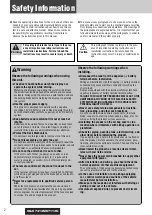
Setting the
SENS
control to
10
gives approximate unity gain
for the
LINE
input. Some sound equipment, including home
consumer products, may operate at a lower level (i.e., -10 dBv)
than professional equipment and, therefore, will require setting
SENS
to a higher gain to reach the same output level.
See Setting Up the System on page 9 to learn how to set
SENS
correctly.
100 Hz Hi-Pass Filter
Pressing this switch activates a steep 18 dB per octave filter
which reduces the level of bass frequencies only. Use this filter
in live PA (public address) situations to clean up the mix,
reducing stage rumble or “popping” from microphones.
Equalizer (EQ)
The 3-band swept equalizer (EQ) allows fine manipulation of
the frequency bands, and is particularly useful for improving
the sound in live PA applications where the original signal is
often far from ideal and where slight boosting or cutting of
particular voice frequencies can dramatically improve clarity.
HF EQ
Turn
HF
to the right to boost high (treble) frequencies (at
12 kHz and above) up to 15 dB, adding crispness to cymbals,
vocals, and electronic instruments. Turn
HF
to the left to cut
the same frequencies up to 15 dB, reducing hiss or excessive
sibilance which can occur with certain types of microphone.
When
HF
is not being used, set it to the center-detent position.
MID EQ
This pair of controls work together to form a mid-frequency EQ
section. The (lower)
MID
gain control provides 15 dB of boost
or cut, just like the
HF
control, but the frequency at which this
occurs can be set by the (upper)
MID
frequency control over a
range of 240 Hz to 6 kHz. This allows some truly creative
improvement of the signal in live situations, because the mid
band covers the range of most vocals. Listen carefully as you use
these controls together to find how particular characteristics of a
signal (i.e., vocal) can be enhanced or reduced. When
MID EQ
is
not being used, set the (lower)
MID
gain control to its center-
detent position.
NOTE: The Q is fixed at 1.5.
LF EQ
Turn
LF
clockwise to boost low (bass) frequencies (at 60 Hz
and below) by up to 15 dB, adding warmth to vocals or extra
punch to synthesizers, guitars, and drums. Turn
LF
anticlock-
wise to cut low frequencies by up to 15 dB to reduce hum,
stage rumble, or to improve a mushy sound. When
LF
is not
being used, set it to the center-detent position.
AUX Sends
Use these controls to set up separate mixes for foldback,
effects, or recording. The combination of each
AUX
Send is
mixed to the respective
AUX
Output at the rear of the mixer.
For effects work, the signal should be post-fade, so it will fade
up and down with the fader. However, for foldback or monitor
feeds, the signal should be pre-fade, so it is independent of the
fader.
AUX 1
is always pre-fade, post-EQ, and would typically be
used as a foldback or monitor feed.
AUX 2
and
AUX 3
are
normally post-fade, post-EQ for use as effects sends or additional
submixes, but for flexibility
AUX 2
may be switched to pre-fade,
post-EQ by pressing the associated
PRE
switch.
All
AUX
Sends are muted, along with the other channel outputs,
when the
MUTE
switch is pressed.
LEX FX
The
LEX FX
control is identical to the post-fade
AUX 3
, but the
signal is sent to the internal bus which feeds the input of the
built-in Lexicon Digital Effects Processor. The output of the
Lexicon processor may be added to the mix or
AUX 1
or
AUX 2
. The more you increase
LEX FX
, the more channel sig-
nal you send to the Lexicon effects unit.
continued on next page...
7
6
5
4
11
M I X E R O P E R A T I O N
Содержание EVOi.sys
Страница 2: ......














































